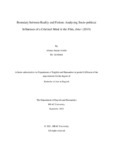| dc.contributor.advisor | Saba, Anika | |
| dc.contributor.author | Anisha, Afsana Anjum | |
| dc.date.accessioned | 2022-01-23T06:22:18Z | |
| dc.date.available | 2022-01-23T06:22:18Z | |
| dc.date.copyright | 2021 | |
| dc.date.issued | 2021-09 | |
| dc.identifier.other | ID 18103064 | |
| dc.identifier.uri | http://hdl.handle.net/10361/15970 | |
| dc.description | This thesis is submitted in partial fulfillment of the requirements for the degree of Bachelor of Arts in English, 2021. | en_US |
| dc.description | Cataloged from PDF version of thesis. | |
| dc.description | Includes bibliographical references (pages 50-55). | |
| dc.description.abstract | For the last few decades, the advancements in visual media have enabled filmmakers to propagate their visions of postmodernist perplexities on the screen, reiterating and reinterpreting their predecessors’ unresolved information to intrigue their audiences. While some aporetic genres are presiding over the Hollywood film industry, Todd Phillips' psychological thriller and post-neorealist cinema Joker (2019) enthralled both spectators and critics. This film illustrates the genesis of the Joker, the prominent arch-enemy of the DC Comics superhero Batman, by condemning late capitalist society. It depicts the gradual metamorphosis of a mentally unstable and sadistic loner turning into a nihilist and vicious serial murderer. The film uses outstanding cinematography and appealing biographical narratives to create an indistinguishable simulacrum of our dystopian and dysfunctional political and social systems.
Therefore, the research for this study is to analyse whether a fictional product of the visual media is influential enough in promoting non-conventional and unethical narratives like the delinquencies portrayed by the enigmatic protagonist of Joker, Arthur Fleck, in spectators' minds to act accordingly. This thesis seeks to resolve this issue by analysing socio-political influences on the construction of a criminal that resonates with reality in postmodernist films using simulated visual representations. Furthermore, this study aims to prove that acting according to a fictitious delinquent is not a notion conveyed by filmmakers, since it is the audiences' responsibility to preserve the fictional boundaries between reality and fiction. | en_US |
| dc.description.statementofresponsibility | Afsana Anjum Anisha | |
| dc.format.extent | 55 pages | |
| dc.language.iso | en | en_US |
| dc.publisher | Brac University | en_US |
| dc.rights | Brac University theses are protected by copyright. They may be viewed from this source for any purpose, but reproduction or distribution in any format is prohibited without written permission. | |
| dc.subject | Hollywood film industry | en_US |
| dc.subject | Joker (2019) | en_US |
| dc.subject | Reality and fiction | en_US |
| dc.subject | Criminal mind | en_US |
| dc.subject | Film | en_US |
| dc.subject.lcsh | Realism in motion pictures. | |
| dc.subject.lcsh | Motion picture plays -- criticism. | |
| dc.title | Boundary between reality and fiction: analysing socio-political influences of a criminal mind in the film, Joker (2019) | en_US |
| dc.type | Thesis | en_US |
| dc.contributor.department | Department of English and Humanities, Brac University | |
| dc.description.degree | B.A. in English | |

